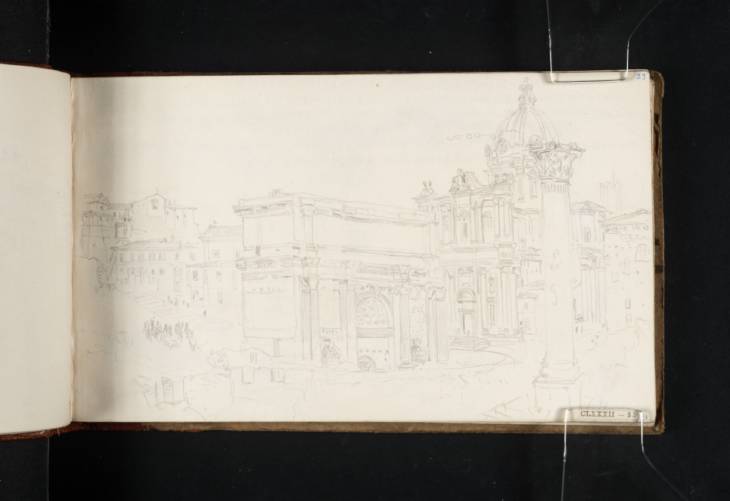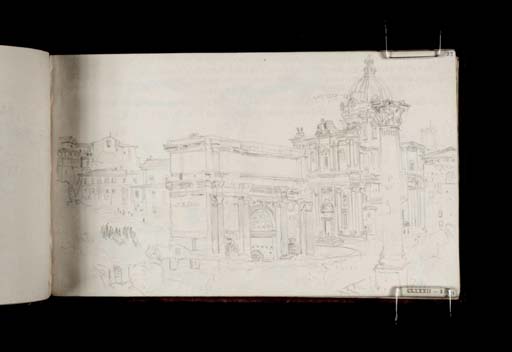Joseph Mallord William Turner The Forum, Rome, with the Arch of Septimius Severus and the Column of Phocas 1819
Image 1 of 2
Joseph Mallord William Turner,
The Forum, Rome, with the Arch of Septimius Severus and the Column of Phocas
1819
Joseph Mallord William Turner 1775–1851
Folio 33 Recto:
The Forum, Rome, with the Arch of Septimius Severus and the Column of Phocas 1819
D15356
Turner Bequest CLXXXII 33
Turner Bequest CLXXXII 33
Pencil on white wove paper, 113 x 189 mm
Inscribed by the artist in pencil ‘x’ on wall of building far left and ‘[?Quarry]’ vertically underneath, ‘Red’ beneath group of figures and ‘MAX’ right-hand side in the middle of the façade of the church of Santi Luca e Martina, ’10 | 8 x 1 | G’ on Column of Phocas and ‘X’ on left of base
Inscribed by John Ruskin in blue ink ‘33’ top right and ‘301’ bottom right
Stamped in black ‘CLXXXII 33’ bottom right
Inscribed by John Ruskin in blue ink ‘33’ top right and ‘301’ bottom right
Stamped in black ‘CLXXXII 33’ bottom right
Accepted by the nation as part of the Turner Bequest 1856
Exhibition history
1971
Classical Sites and Monuments, British Museum, London, July–October 1971 (68).
References
1909
A.J. Finberg, A Complete Inventory of the Drawings of the Turner Bequest, London 1909, vol.I, p.537, as ‘Arch of Septimus Severus in Forum, with Column of Phocas in foreground’.
1914
Thomas Ashby, ‘Turner in Rome – II’, Burlington Magazine, vol.25, no.134, May 1914, p.104.
1971
Andrew Wilton, Classical Sites and Monuments, exhibition catalogue, British Museum, London 1971, no.68, [p.16], as ‘The Arch of Septimius Severus, Rome’.
This sketch shows the northern corner of the Roman Forum. The central focus is the Arch of Septimius Severus, a triumphal arch in white marble erected in AD 203 to celebrate the tenth anniversary of the accession of the titular emperor and to commemorate his Parthian victories, and those of his two sons, Geta and Caracalla. The excavation of the arch began in the early nineteenth century (1801–3) and Turner’s sketch shows that when he saw it in 1819 it was still partially embedded.1 However, his drawing is somewhat misleading since it suggests that the level of the buried part of the monument began the bottom of the Corinthian columns. Other studies reveal that part of the eastern façade at least was uncovered to the column bases, see folio 34 (D15358) and Small Roman Colour Studies sketchbook (Turner Bequest CXC 11a; Tate D16408). On the following page overleaf, Turner transcribed the Latin inscription visible on the attic, see folio 33 verso (D15357).
The Baroque façade and dome beyond the Arch belongs to the Church of Santi Luca e Martina, whilst to the right of that is the corner of the Curia, a replica of the hall where the Senate used to sit. In the right-hand foreground is the Column of Phocas, a fluted Corinthian column erected in 608 AD which stands 44 feet high (13.5m). Although described by Byron in Childe Harold’s Pilgrimage as ‘Thou nameless column with the buried base’, by the time of Turner’s visit in 1819 the anonymous monument had in fact acquired an identity.2 Excavations by Lady Elizabeth Foster, Duchess of Devonshire, revealed an inscription on the base stating that the column had once held a statue of the Byzantine emperor Phocas. On the following page Turner made a more detailed sketch of the base with the steps leading up to it.
For a general discussion of Turner’s depictions of the Forum see folio 32 (D15355).
Nicola Moorby
May 2008
How to cite
Nicola Moorby, ‘The Forum, Rome, with the Arch of Septimius Severus and the Column of Phocas 1819 by Joseph Mallord William Turner’, catalogue entry, May 2008, in David Blayney Brown (ed.), J.M.W. Turner: Sketchbooks, Drawings and Watercolours, Tate Research Publication, December 2012, https://www


